Flow and Heat Transfer Characteristics of Supercritical N-Decane in Adjacent Cooling Channels with Opposite Flow Directions
Abstract
:1. Introduction
2. Computational Domain
3. Results
3.1. Numerical Methods
3.2. Thermophysical Properties
3.3. Validation of the Numerical Simulations and Mesh Sensitivity Determination
4. Results and Discussion
4.1. Description of the Wall and Fluid Temperatures
4.2. Effect of the Heat Flux
4.3. Effect of the Gravity
5. Conclusions
- Compared to cooling channels with the same flow direction, the application of adjacent cooling channels with opposite flow directions is beneficial to the reduction in the maximum wall temperature. The maximum wall temperature is reduced by 9.07% only by changing the flow direction under current case, which prevents the occurrence of local high wall temperatures.
- The development of two small recirculation zones along the flow direction can be observe in the cooling channels. With increasing heat flux, the occurrence range of the small recirculation zones obviously expands, and the asymmetry of the whole flow field becomes more obvious.
- The gravity effect plays an important role in the generation of small recirculation zones in cooling channels. The small recirculation zones induced by the buoyancy force narrow, and flow asymmetry is inhibited when the gravity and heat flux directions remain the same. The occurrence of flow asymmetry may be closely related to the interaction between hot and cold fluids.
Author Contributions
Funding
Institutional Review Board Statement
Informed Consent Statement
Data Availability Statement
Conflicts of Interest
Nomenclature
| Din | inner diameter (m) |
| Dout | outer diameter (m) |
| P | pressure (MPa) |
| Q | wall heat flux (W/m2) |
| T | temperature (K) |
| Cp | specific heat of the fluid (J/kg·K) |
| G | mass flow rate (kg/h) |
| X, Y, Z | streamwise direction, normal direction and spanwise direction |
| Subscripts | |
| w | wall |
| f | fluid |
References
- Fry, R.S. A Century of Ramjet Propulsion Technology Evolution. J. Propuls. Power 2004, 20, 27–58. [Google Scholar] [CrossRef]
- Zhu, Y.; Peng, W.; Xu, R.; Jiang, P. Review on active thermal protection and its heat transfer for airbreathing hypersonic vehicles. Chin. J. Aeronaut. 2018, 31, 1929–1953. [Google Scholar] [CrossRef]
- Jeong, S.-M.; Choi, J.-Y. Combined Diagnostic Analysis of Dynamic Combustion Characteristics in a Scramjet Engine. Energies 2020, 13, 4029. [Google Scholar] [CrossRef]
- Ning, W.; Yu, P.; Jin, Z. Research status of active cooling of endothermic hydrocarbon fueled scramjet engine. Proc. Inst. Mech. Eng. Part G J. Aerosp. Eng. 2012, 227, 1780–1794. [Google Scholar] [CrossRef]
- Gascoin, N.; Abraham, G.; Gillard, P. Synthetic and jet fuels pyrolysis for cooling and combustion applications. J. Anal. Appl. Pyrolysis 2010, 89, 294–306. [Google Scholar] [CrossRef] [Green Version]
- DeWitt, M.J.; Edwards, T.; Shafer, L.; Brooks, D.; Striebich, R.; Bagley, S.P.; Wornat, M.J. Effect of Aviation Fuel Type on Pyrolytic Reactivity and Deposition Propensity under Supercritical Conditions. Ind. Eng. Chem. Res. 2011, 50, 10434–10451. [Google Scholar] [CrossRef]
- Sreekireddy, P.; Reddy, T.K.K.; Selvaraj, P.; Reddy, V.M.; Lee, B.J. Analysis of active cooling panels in a scramjet combustor considering the thermal cracking of hydrocarbon fuel. Appl. Therm. Eng. 2019, 147, 231–241. [Google Scholar] [CrossRef]
- Tu, J.; Jinlong, P.; Xianning, Y.; Lianzhong, C. Experimental Investigations on Active Cooling Thermal Protection Structure of Hydrocarbon-Fueled Scramjet Combustor in Arc Heated Facility. AIP Conf. Proc. 2016, 1770, 040021. [Google Scholar]
- Qin, J.; Bao, W.; Zhou, W.; Yu, D. Flow and heat transfer characteristics in fuel cooling channels of a recooling cycle. Int. J. Hydrogen Energy 2010, 35, 10589–10598. [Google Scholar] [CrossRef]
- Jiang, Y.; Xu, Y.; Qin, J.; Zhang, S.; Chetehouna, K.; Gascoin, N.; Bao, W. The flow rate distribution of hydrocarbon fuel in parallel channels with different cross section shapes. Appl. Therm. Eng. 2018, 137, 173–183. [Google Scholar] [CrossRef]
- Zhu, J.; Zhao, C.; Cheng, Z.; Lin, D.; Tao, Z.; Qiu, L. Experimental investigation on heat transfer of n-decane in a vertical square tube under supercritical pressure. Int. J. Heat Mass Transf. 2019, 138, 631–639. [Google Scholar] [CrossRef]
- Lei, Z.; Liu, B.; Huang, Q.; He, K.; Bao, Z.; Zhu, Q.; Li, X. Thermal cracking characteristics of n-decane in the rectangular and circular tubes. Chin. J. Chem. Eng. 2019, 27, 2876–2883. [Google Scholar] [CrossRef]
- Jiao, S.; Li, S.; Pu, H.; Dong, M.; Shang, Y. Experimental investigation on thermal cracking and convective heat transfer characteristics of aviation kerosene RP-3 in a vertical tube under supercritical pressures. Int. J. Therm. Sci. 2019, 146, 106092. [Google Scholar] [CrossRef]
- Jiang, P.-X.; Wang, Y.; Zhu, Y. Differential Global Reaction Model with Variable Stoichiometric Coefficients for Thermal Cracking of n-Decane at Supercritical Pressures. Energy Fuels 2019, 33, 7244–7256. [Google Scholar] [CrossRef]
- Pu, H.; Li, S.; Dong, M.; Jiao, S.; Wang, Y.; Shang, Y. Convective heat transfer and flow resistance characteristics of supercritical pressure hydrocarbon fuel in a horizontal rectangular mini-channel. Exp. Therm. Fluid Sci. 2019, 108, 39–53. [Google Scholar] [CrossRef]
- Zhu, K.; Xu, G.-Q.; Tao, Z.; Deng, H.-W.; Ran, Z.-H.; Zhang, C.-B. Flow frictional resistance characteristics of kerosene RP-3 in horizontal circular tube at supercritical pressure. Exp. Therm. Fluid Sci. 2013, 44, 245–252. [Google Scholar] [CrossRef]
- Asadi, M.; Xie, G.; Sunden, B. A review of heat transfer and pressure drop characteristics of single and two-phase microchannels. Int. J. Heat Mass Transf. 2014, 79, 34–53. [Google Scholar] [CrossRef]
- Pan, H.; Bi, Q.; Liu, Z.; Feng, S.; Feng, F. Experimental investigation on thermo-acoustic instability and heat transfer of supercritical endothermic hydrocarbon fuel in a mini tube. Exp. Therm. Fluid Sci. 2018, 97, 109–118. [Google Scholar] [CrossRef]
- Wang, H.; Wang, H.; Nie, W.; Su, L.; Yang, X. Investigation on the Mechanism of Thermoacoustic Instability of n-Decane at Subcritical Pressure. AIAA J. 2018, 56, 2635–2641. [Google Scholar] [CrossRef]
- Wang, Y.; Li, S.; Dong, M. Experimental investigation on heat transfer deterioration and thermo-acoustic instability of supercritical-pressure aviation kerosene within a vertical upward circular tube. Appl. Therm. Eng. 2019, 157, 113707. [Google Scholar] [CrossRef]
- Liu, B.; Zhu, Y.; Yan, J.-J.; Lei, Y.; Zhang, B.; Jiang, P.-X. Experimental investigation of convection heat transfer of n-decane at supercritical pressures in small vertical tubes. Int. J. Heat Mass Transf. 2015, 91, 734–746. [Google Scholar] [CrossRef]
- Wang, Y.; Li, S.; Dong, M. Numerical Study on Heat Transfer Deterioration of Supercritical n-Decane in Horizontal Circular Tubes. Energies 2014, 7, 7535–7554. [Google Scholar] [CrossRef] [Green Version]
- Toghraie, D. Numerical Thermal Analysis of Water’s Boiling Heat Transfer Based on a Turbulent Jet Impingement on Heated Surface. Phys. E Low Dimens. Syst. Nanostruct. 2016, 84, 454–465. [Google Scholar] [CrossRef]
- Pourfattah, F.; Motamedian, M.; Sheikhzadeh, G.; Toghraie, D.; Akbari, O.A. The numerical investigation of angle of attack of inclined rectangular rib on the turbulent heat transfer of Water-Al2O3 nanofluid in a tube. Int. J. Mech. Sci. 2017, 131-132, 1106–1116. [Google Scholar] [CrossRef]
- Parsaiemehr, M.; Pourfattah, F.; Akbari, O.A.; Toghraie, D.; Sheikhzadeh, G. Turbulent flow and heat transfer of Water/Al2O3 nanofluid inside a rectangular ribbed channel. Phys. E Low Dimens. Syst. Nanostruct. 2018, 96, 73–84. [Google Scholar] [CrossRef]
- Alipour, H.; Karimipour, A.; Safaei, M.R.; Semiromi, D.T.; Akbari, O.A. Influence of T-semi attached rib on turbulent flow and heat transfer parameters of a silver-water nanofluid with different volume fractions in a three-dimensional trapezoidal microchannel. Phys. E Low Dimens. Syst. Nanostruct. 2017, 88, 60–76. [Google Scholar] [CrossRef]
- Akbari, O.A.; Toghraie, D.; Karimipour, A. Numerical simulation of heat transfer and turbulent flow of water nanofluids copper oxide in rectangular microchannel with semi-attached rib. Adv. Mech. Eng. 2016, 8. [Google Scholar] [CrossRef] [Green Version]
- Ruan, B.; Huang, S.; Meng, H.; Gao, X. Flow dynamics in transient heat transfer of n-decane at supercritical pressure. Int. J. Heat Mass Transf. 2017, 115, 206–215. [Google Scholar] [CrossRef]
- Li, Y.; Sun, F.; Sunden, B.; Xie, G. Turbulent heat transfer characteristics of supercritical n -decane in a vertical tube under various operating pressures. Int. J. Energy Res. 2019, 43, 4652–4669. [Google Scholar] [CrossRef]
- Zhang, L.; Zhang, R.; Xiao, S.; Jiang, J.; Le, J. Experimental investigation on heat transfer correlations of n-decane under supercritical pressure. Int. J. Heat Mass Transf. 2013, 64, 393–400. [Google Scholar] [CrossRef]
- Wang, N.; Pan, Y. Correlation for heat transfer of RP-3 kerosene flowing in miniature tube at supercritical pressures. Mod. Phys. Lett. B 2020, 34. [Google Scholar] [CrossRef]
- Li, Y.; Chen, Y.; Zhang, Y.; Sun, F.; Xie, G. An Improved Heat Transfer Correlation for Supercritical Aviation Kerosene Flowing Upward and Downward in Vertical Tubes. J. Therm. Sci. 2019, 29, 131–143. [Google Scholar] [CrossRef]
- Feng, Y.; Cao, J.; Li, X.; Zhang, S.; Qin, J.; Rao, Y. Flow and Heat Transfer Characteristics of Supercritical Hydrocarbon Fuel in Mini Channels With Dimples. J. Heat Transf. 2017, 139, 122401–12240111. [Google Scholar] [CrossRef]
- Hosseinnezhad, R.; Akbari, O.A.; Afrouzi, H.H.; Biglarian, M.; Koveiti, A.; Toghraie, D. Numerical study of turbulent nanofluid heat transfer in a tubular heat exchanger with twin twisted-tape inserts. J. Therm. Anal. Calorim. 2017, 132, 741–759. [Google Scholar] [CrossRef]
- Jiang, Y.; Feng, Y.; Zhang, S.; Qin, J.; Bao, W. Numerical heat transfer analysis of transcritical hydrocarbon fuel flow in a tube partially filled with porous media. Open Phys. 2016, 14, 659–667. [Google Scholar] [CrossRef] [Green Version]
- Li, X.; Qin, J.; Zhang, S.; Cui, N.; Bao, W. Effects of Microribs on the Thermal Behavior of Transcritical n-Decane in Asymmetric Heated Rectangular Mini-Channels Under Near Critical Pressure. J. Heat Transf. 2018, 140. [Google Scholar] [CrossRef]
- Ahn, H.S.; Lee, S.W.; Lau, S.C. Heat Transfer Enhancement for Turbulent Flow Through Blockages With Round and Elongated Holes in a Rectangular Channel. J. Heat Transf. 2007, 129, 1611–1615. [Google Scholar] [CrossRef]
- Lei, Z.; He, K.; Huang, Q.; Bao, Z.; Li, X. Numerical study on supercritical heat transfer of n-decane during pyrolysis in rectangular tubes. Appl. Therm. Eng. 2020, 170, 115002. [Google Scholar] [CrossRef]
- Sengen, A.-L.; Herbstritt, F.; Gruenewald, M.; Heck, J. Experimental Investigation of the Convective Heat Transfer Coefficient in a Rectangular Microchannel. Chem. Ing. Tech. 2017, 89, 379–389. [Google Scholar] [CrossRef]
- Lu, Z.; Zhu, Y.; Guo, Y.; Jiang, P. Experimental Investigation of Convective Heat Transfer of Supercritical Pressure Hydrocarbon Fuel in a Horizontal Section of a Rotating U-Duct. J. Heat Transf. 2019, 141. [Google Scholar] [CrossRef]
- Sui, Y.; Teo, C.; Lee, P.; Chew, Y.; Shu, C. Fluid flow and heat transfer in wavy microchannels. Int. J. Heat Mass Transf. 2010, 53, 2760–2772. [Google Scholar] [CrossRef]
- Mohammed, H.; Gunnasegaran, P.; Shuaib, N. Numerical simulation of heat transfer enhancement in wavy microchannel heat sink. Int. Commun. Heat Mass Transf. 2011, 38, 63–68. [Google Scholar] [CrossRef]
- Kumar, V.R.; Balasubramanian, K.; Kumar, K.K.; Tiwari, N.; Bhatia, K. Numerical investigation of fluid flow and heat transfer characteristics in novel circular wavy microchannel. Proc. Inst. Mech. Eng. Part E J. Process. Mech. Eng. 2018, 233, 954–966. [Google Scholar] [CrossRef]
- Bazdar, H.; Toghraie, D.; Pourfattah, F.; Akbari, O.A.; Nguyen, H.M.; Asadi, A. Numerical investigation of turbulent flow and heat transfer of nanofluid inside a wavy microchannel with different wavelengths. J. Therm. Anal. Calorim. 2020, 139, 2365–2380. [Google Scholar] [CrossRef]
- Cheong, W.K.; Muezzin, F.N.B.A. Heat Transfer of a Double Layer Microchannel Heat Sink. Appl. Mech. Mater. 2013, 479, 411–415. [Google Scholar] [CrossRef]
- Shen, H.-M.; Jin, X.; Zhang, F.; Xie, G.; Sunden, B.; Yan, H. Computational optimization of counter-flow double-layered microchannel heat sinks subjected to thermal resistance and pumping power. Appl. Therm. Eng. 2017, 121, 180–189. [Google Scholar] [CrossRef]
- Liu, Y.; Xie, G.; Sunden, B.A. Effect of wall conduction on the heat transfer characteristics of supercritical n-decane in a horizontal rectangular pipe for cooling of a scramjet combustor. Int. J. Numer. Methods Heat Fluid Flow 2020. [Google Scholar] [CrossRef]
- Zhao, H.; Li, X.; Wu, X. Numerical investigation of supercritical water turbulent flow and heat transfer characteristics in vertical helical tubes. J. Supercrit. Fluids 2017, 127, 48–61. [Google Scholar] [CrossRef]
- Li, Y.; Sun, F.; Xie, G.; Sunden, B.; Qin, J. Numerical investigation on flow and thermal performance of supercritical CO2 in horizontal cylindrically concaved tubes. Appl. Therm. Eng. 2019, 153, 655–668. [Google Scholar] [CrossRef]
- Marcia, L.H. NIST Standard Reference Database 4. NIST Thermophysical Properties of Hydrocarbon Mixtures (SuperTrapp): Version 3.2; National Institute of Standards and Technology: Gaithersburg, MA, USA, 2007; pp. 3–36.

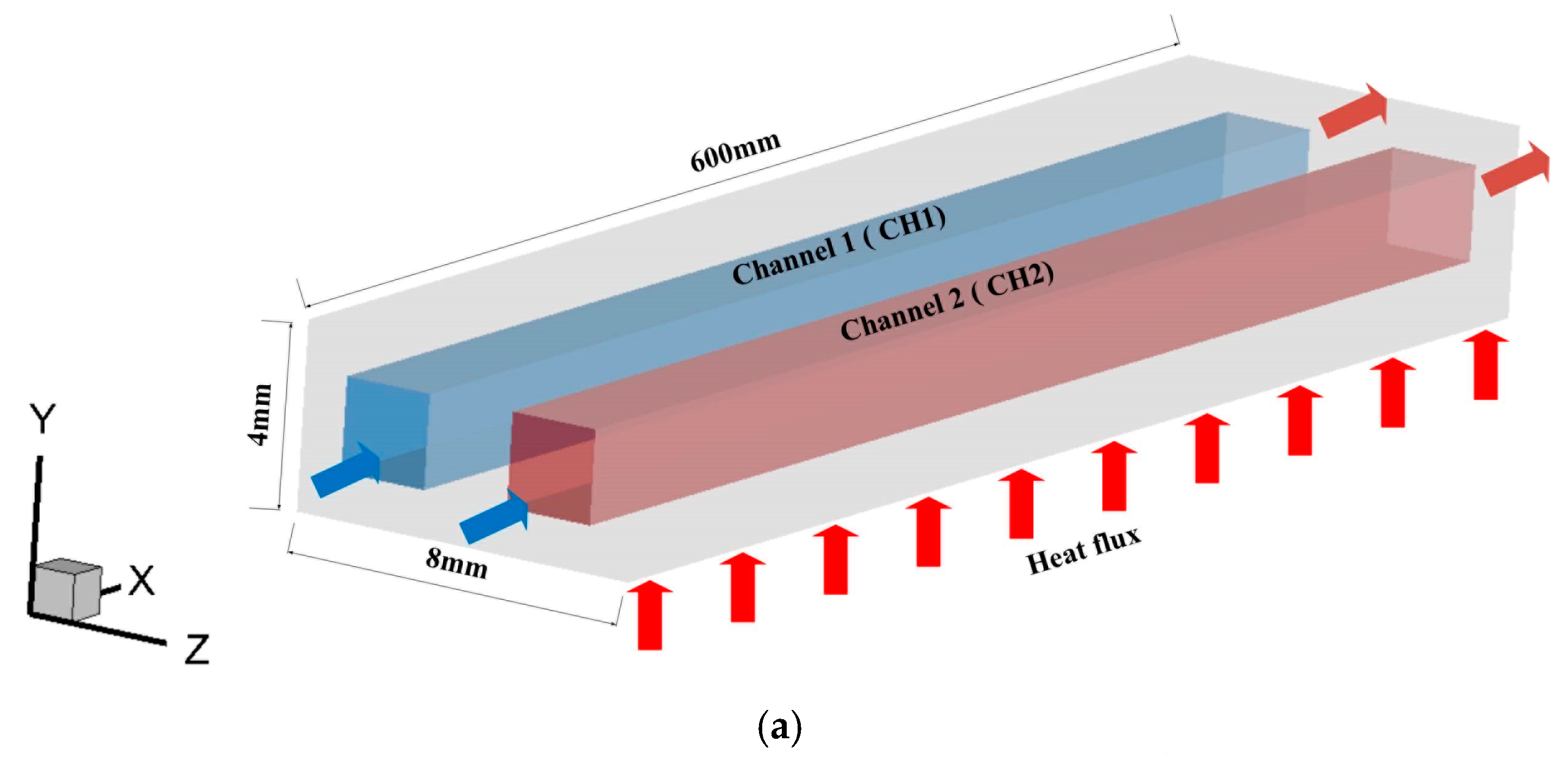

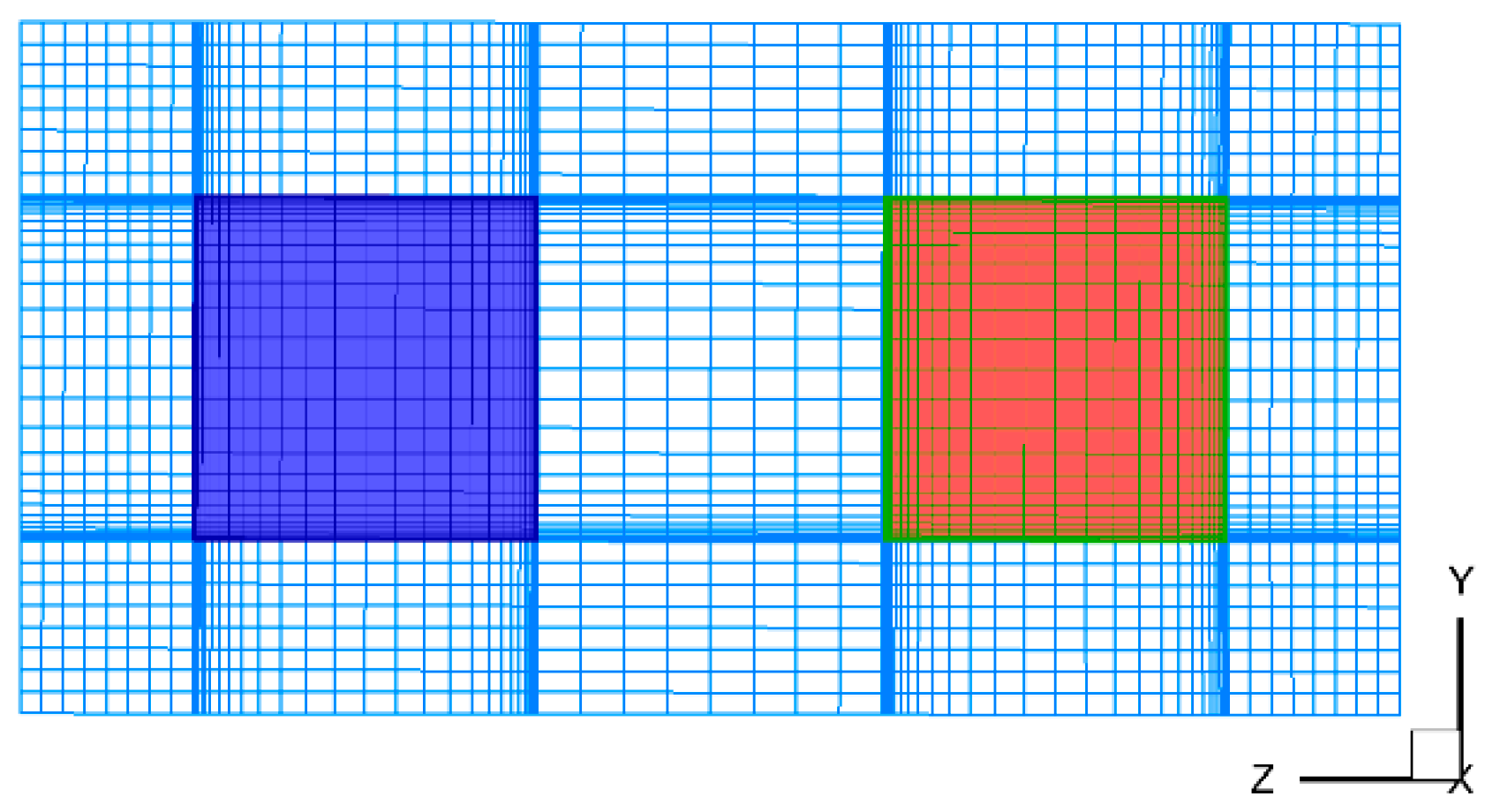
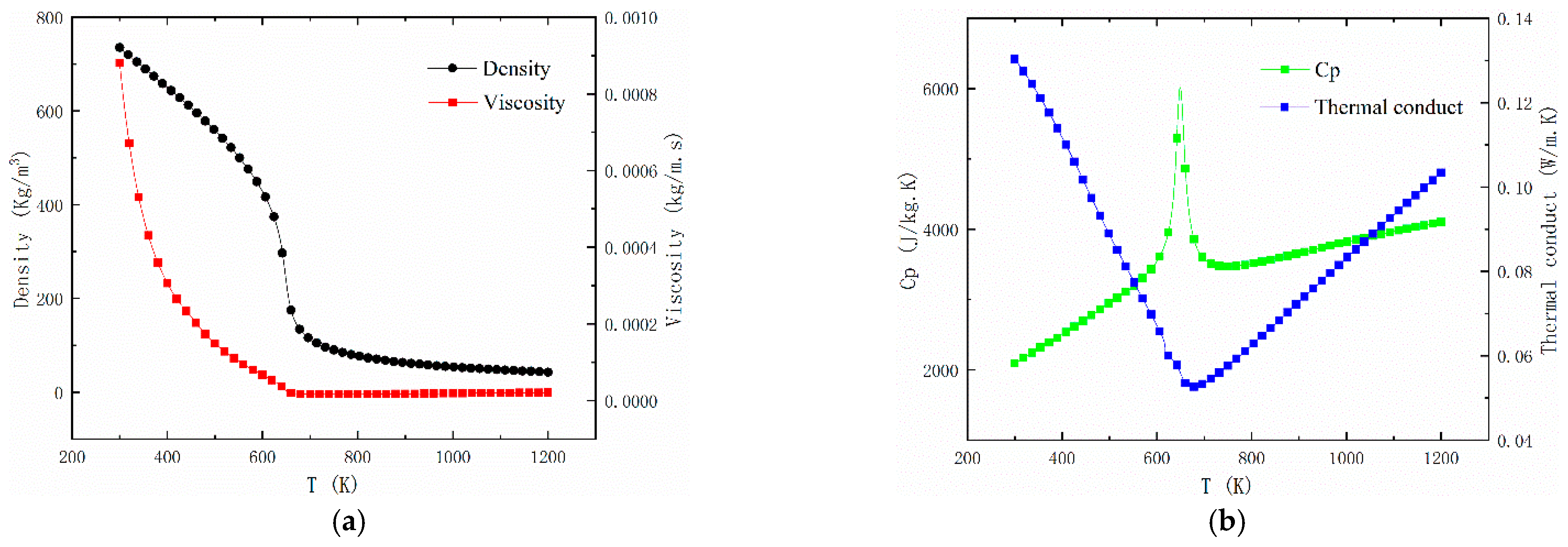
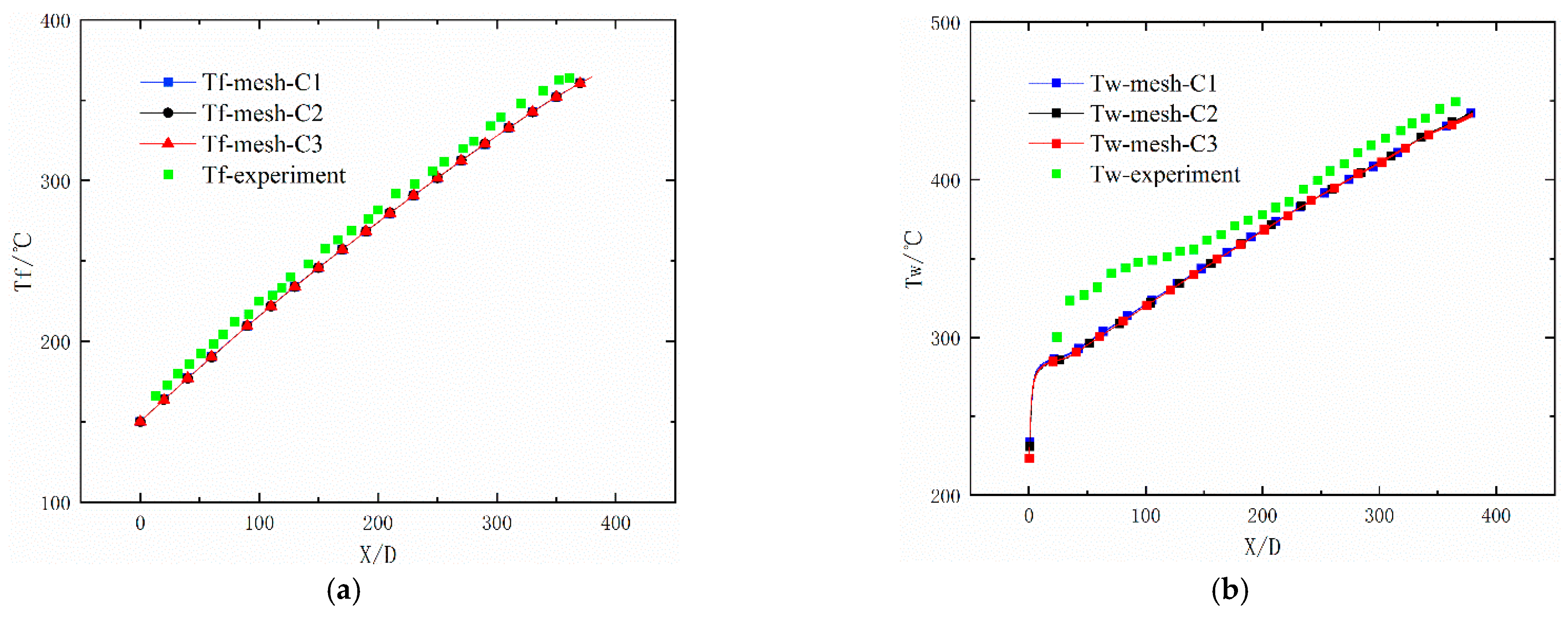
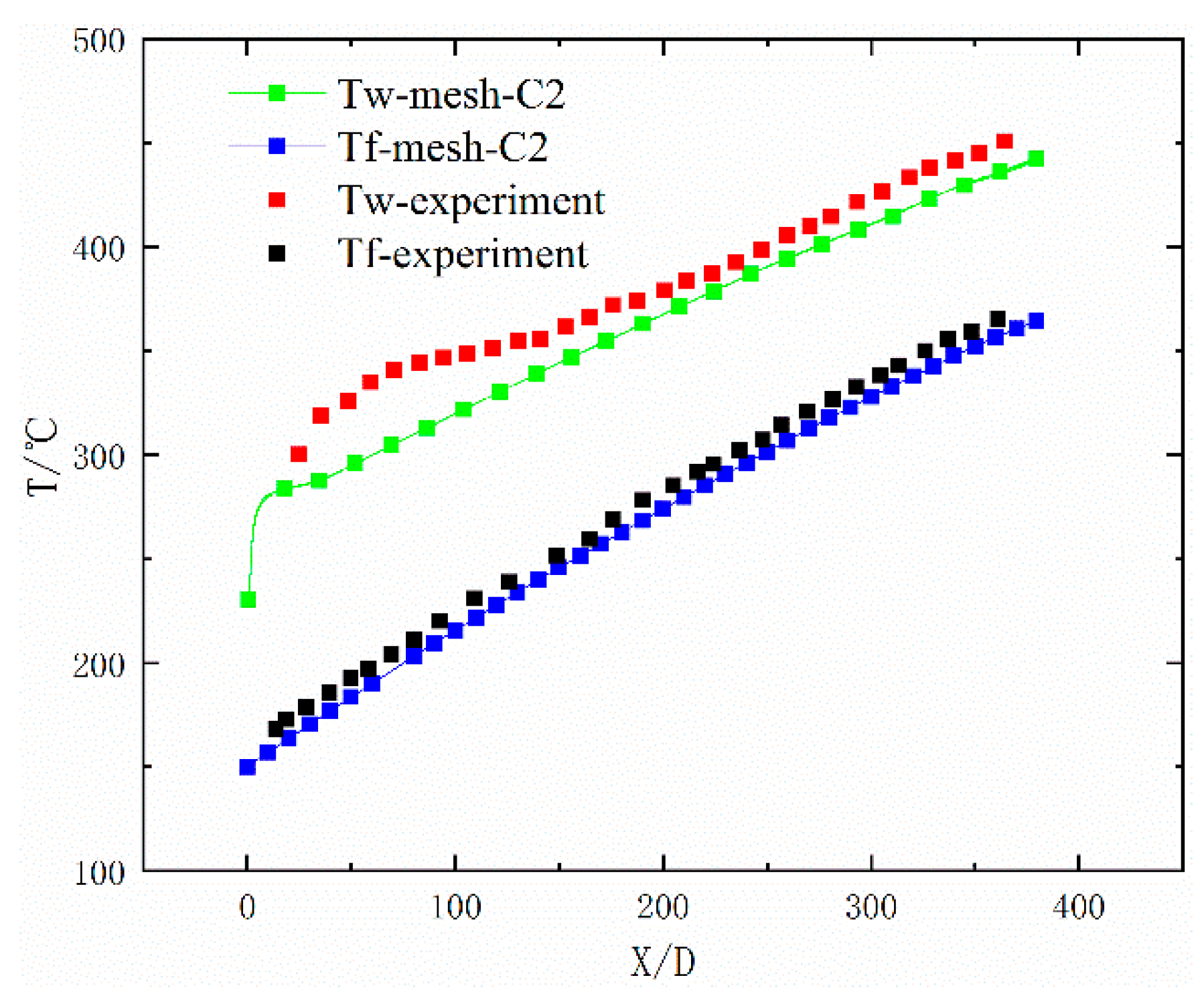


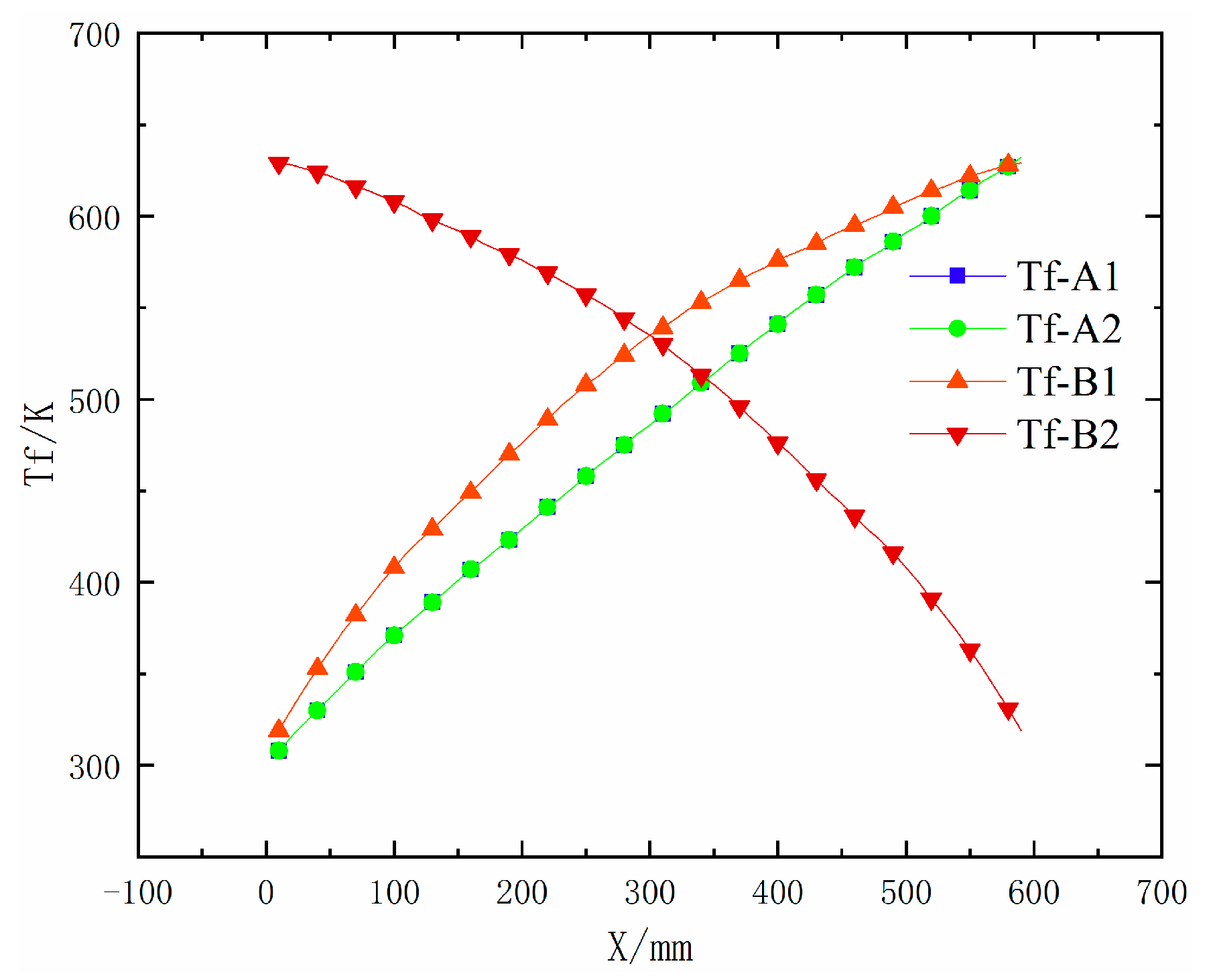
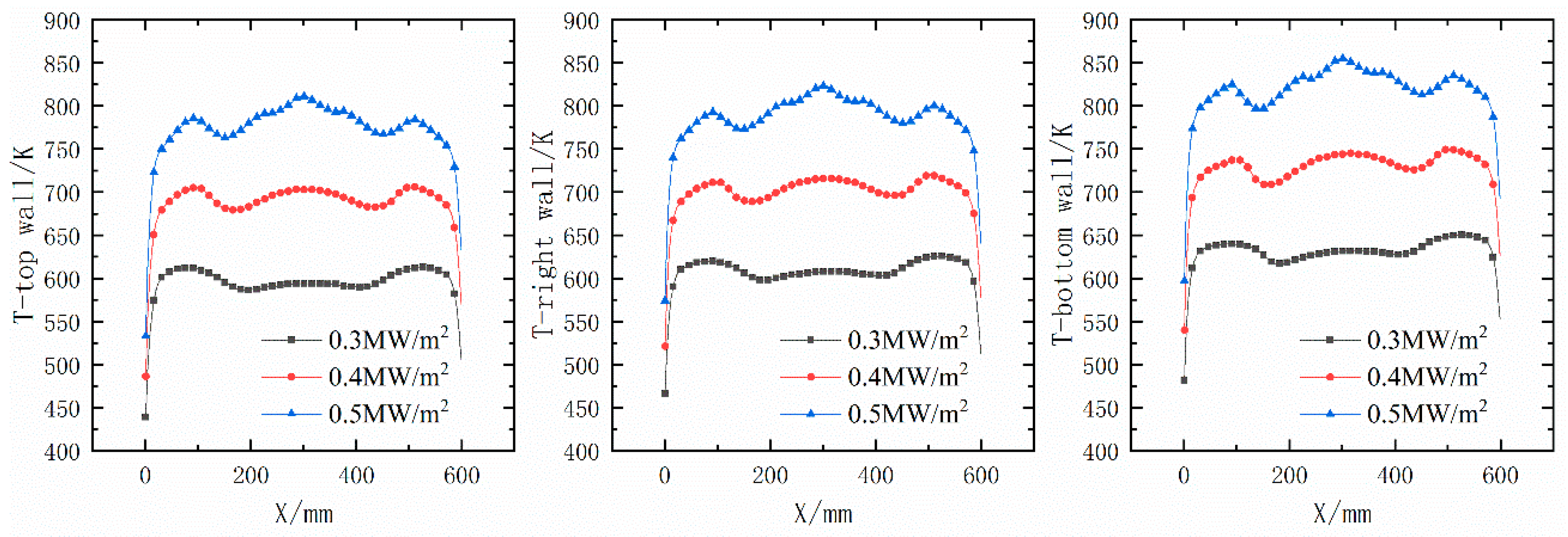
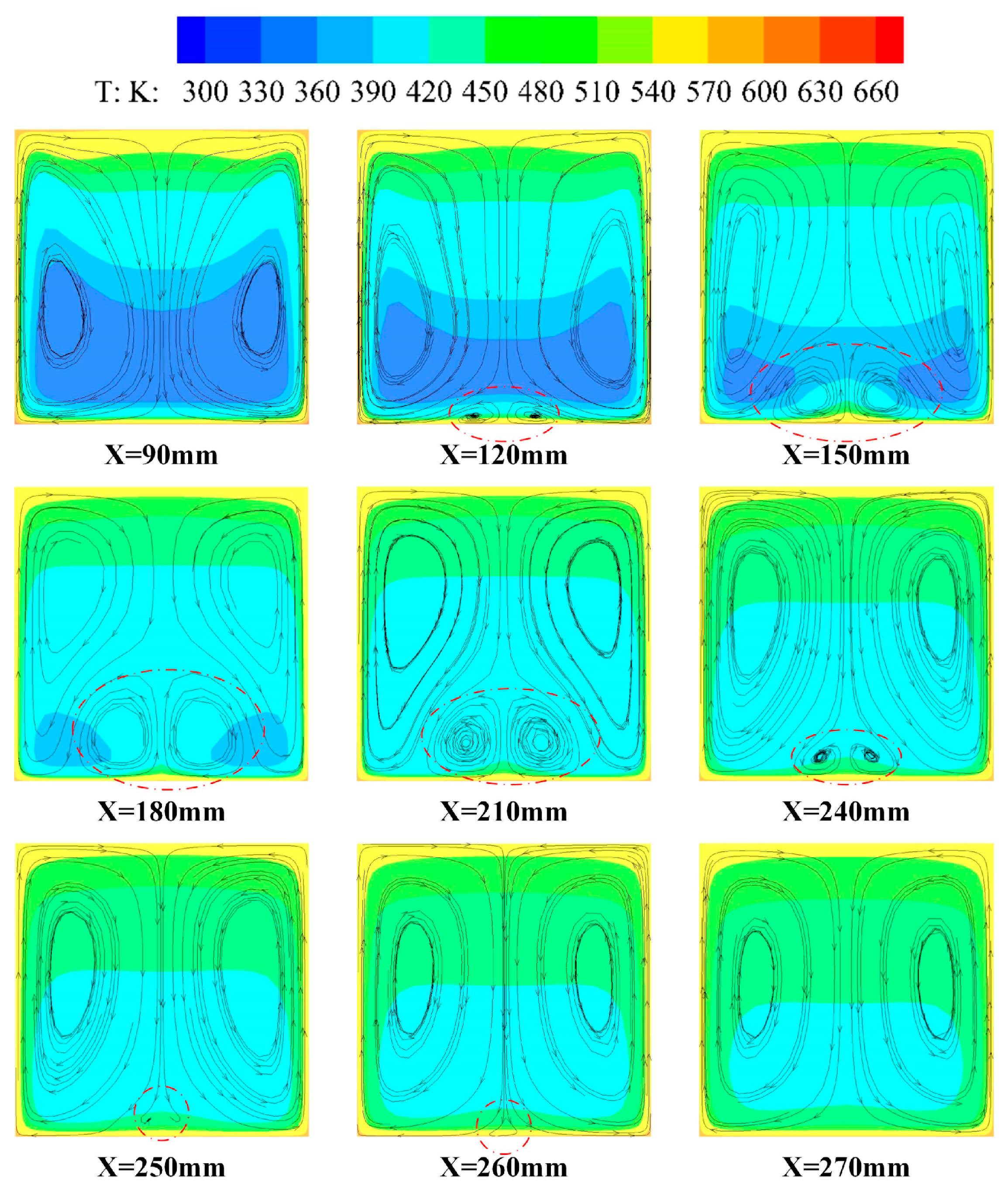


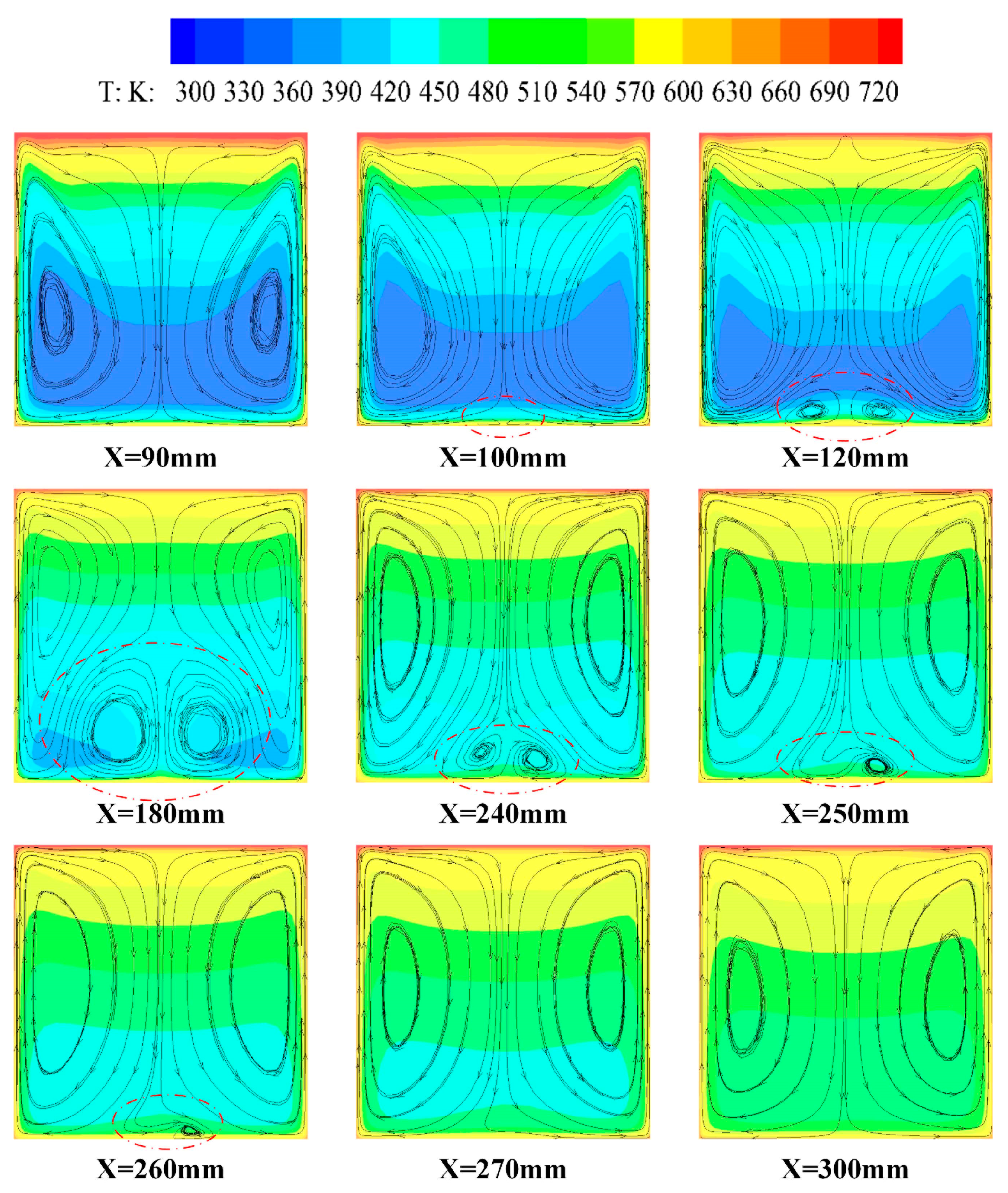


| Mesh Number (Million) | Temperature of Outlet 1 (K) | Temperature of Outlet 2 (K) |
|---|---|---|
| 1.74 | 625.69 | 625.69 |
| 2.85 | 625.86 | 625.86 |
| 4.60 | 625.78 | 625.78 |
Publisher’s Note: MDPI stays neutral with regard to jurisdictional claims in published maps and institutional affiliations. |
© 2021 by the authors. Licensee MDPI, Basel, Switzerland. This article is an open access article distributed under the terms and conditions of the Creative Commons Attribution (CC BY) license (http://creativecommons.org/licenses/by/4.0/).
Share and Cite
Jia, D.; Wang, N.; Pan, Y.; Liu, C.; Wang, S.; Yang, K.; Liu, J. Flow and Heat Transfer Characteristics of Supercritical N-Decane in Adjacent Cooling Channels with Opposite Flow Directions. Energies 2021, 14, 1071. https://doi.org/10.3390/en14041071
Jia D, Wang N, Pan Y, Liu C, Wang S, Yang K, Liu J. Flow and Heat Transfer Characteristics of Supercritical N-Decane in Adjacent Cooling Channels with Opposite Flow Directions. Energies. 2021; 14(4):1071. https://doi.org/10.3390/en14041071
Chicago/Turabian StyleJia, Dongpeng, Ning Wang, Yu Pan, Chaoyang Liu, Shiwei Wang, Kai Yang, and Jian Liu. 2021. "Flow and Heat Transfer Characteristics of Supercritical N-Decane in Adjacent Cooling Channels with Opposite Flow Directions" Energies 14, no. 4: 1071. https://doi.org/10.3390/en14041071






